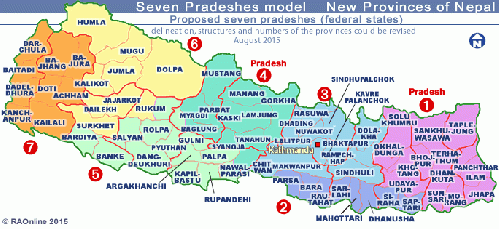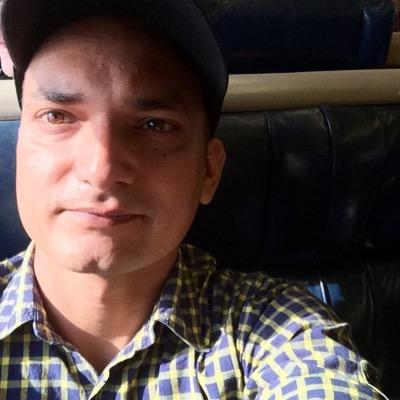
The seven provinces of Nepal endorsed by the new constitution. Courtesy: RAonline
(Image by RAonline) Details DMCA
Of late, Nepal's struggle for democratic and political stabilization -- previously hindered by the then Maoist insurgents and now obstructed by the Madhesi protesters -- rests on how the Asian nation bordering China and India tackles the thorny issue of federating the country into several provinces.
As the local political parties based on Madhesi ethnic group would put it, they want two big provinces in Nepal's southern plains against the present proposal of seven-province model in the whole country. They claim that the seven-province model has chopped off their traditional homeland into pieces. This claim, however, needs some reality checks.
More than 80 percent of Nepal's Madhesi population lives in 8 districts of central plains from Saptari to Parsa -- the region marked as Province No 2 in the newly promulgated constitution. In the eastern plains comprising three districts of Jhapa, Morang and Sunsari, which have been claimed by the Madhesis, they constitute only around 20 percent of the total population. In the western plains comprising three districts of Nawalparasi, Rupandehi and Kapilvastu, Madhesis represent only 30 percent of the entire population. In the mid-western and far-western plains from Dang to Kanchanpur, Madhesi population is below 5 percent.
Despite the distinct and self-defining population figure, some ultra Madhesi leaders argue that the whole southern Terai plains had been their traditional homeland and the eastern plains, too, should be merged with Province No 2. There are some factual errors in their claims, though. Nepal's Terai for centuries has remained a hinterland covered with thick jungles. There were only some sporadic patches of settlements of ethnic Tharu population. The hill tribes did not occupy the already inhibited area, nor did they drive away the already settled people. They cleared the forest, fought with dengue and malaria and established new settlements. In the mean time, the Madhesis, whose culture and tradition is same as the people of Bihar and Uttar Pradesh of India, came onto the scene. When Nepal's cross-border trade started to boom in the late 19th and early 20th century, Madhesis basically entered Nepal as the economic migrants and settled on the two sides of Nepal-India border to facilitate and reap the benefits of cross-country trade. As an evidence of this historical pattern, more than 90 percent of Madhesi population today is concentrated within the 10 kilometers periphery of Nepal's border with India. Nepal's liberal policy helped Madhesis properly settle down, get married, mix up with mainstream Nepalese society, carry out livelihood activities and take part in politics, too.
The Madhesi political parties, which have been protesting against the federal demarcation, in fact, represent only 10 percent of the total Madhesi population. The other 90 percent Madhesis have either voted for or are affiliated with the national political parties including Nepali Congress, CPN-UML and UCPN (M).
In this backdrop, the Indian government's backing to unrealistic demands of Madhesi protesters and the subsequent blockage of Nepal's trade points with India stoped the passage of fuel and the daily commodities have come under the fair scrutiny of the international community. In a statement, the United Nations has stressed on the transit rights of landlocked Nepal, while The Wall Street Journal has strongly emphasized in its editorial that India is spearheading Balkanization of Nepal. The Foreign Policy magazine of the U.S. has said that by blocking the import of petroleum products and other commodities, India has pushed Nepal into the arms of China, as Nepal has signed an agreement with China to divert the commodity imports from India to China.
Yet in another blunder India has committed against Nepal is that India mistook Nepal for Bhutan. Bhutan is a country of less than a million people and its foreign policy is officially guided by the Indian Ministry of External Affairs. A slight deviation in Bhutan's foreign policy in 2013 triggered India to impose economic blockage on Bhutan, topple the then incumbent government in the next election, and thereby pave the way for a new government formation. In a similar manner, unhappy with Nepal's new constitution endorsed by 89 percent of Constituent Assembly members, India blocked the passage of fuel and daily commodities to Nepal and encouraged Madhesi political parties to stage protests on Nepal-India trade points. Even after these attempts, Nepal signed a trade agreement to import commodities from China to substitute the petro-products India was denying to supply to Nepal, and internationalized the issue to a large extent. Nepal, a country of 28 million people, has succeeded for centuries to comfortably exist between two relatively stronger neighbors - India to the south and China to the north - no matter who were the rulers in those countries. India failed to understand this very inherent character of Nepal in the present imbroglio.
Fifty percent of Nepal's population lives in the Terai plains. Madhesis account for 50 percent of the population of the Terai plains and 25 percent of Nepal's total population. Just like other Nepalese citizens, Madhesis too have every right to raise their voice. However, the practical solution would be to come down to a point where all the sides agree to a realistic way out. Therefore, the claim of merging hill-tribes-majority eastern Terai plains with Madhesi-majority Province No 2 would be impractical. Even if the Madhesi-dominant southern parts of Morang and Sunsari districts (of eastern Terai) are to be merged with Province No 2, it has to be reciprocated with the merger of hill-tribes-majority northern parts of eight central Terai districts with Province No 1 and 3 inhibited by the hill-tribes. As per the settlement pattern, such a merger of the northern parts of central Terai from Saptari to Parsa districts would start from 10 km south of East-West Highway to upward. In the west, a province from Dang (mid-western Terai) to Kanchanpur (far-western Terai) could be developed into a single province to ensure justice to Tharu community. Once the disputing sides agree on the practical demarcation of provinces, Nepal could then probably be able to walk on the still-challenging path of stabilization.





